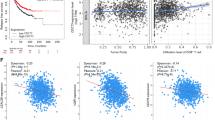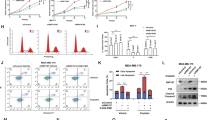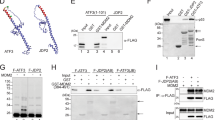Abstract
The Cullin4A (cul4A)-dependent ligase (CDL4A) E3 has been implicated in a variety of biological processes, including cell cycle progression and DNA damage response. Remarkably, CDL4A exerts its function through both proteolytic and non-proteolytic events. Here, we show that the p53 family member p73 is able to interact with the CDL4A complex through its direct binding to the receptor subunit DNA-binding protein 1 (DDB1). As a result, the CDL4A complex is able to monoubiquitylate p73. Modification of p73 by CDL4A-mediated ubiquitylation does not affect p73 protein stability, but negatively regulates p73-dependent transcriptional activity. Indeed, genetic or RNA interference-mediated depletion of DDB1 induces the expression of several p73 target genes in a p53-independent manner. In addition, by exploiting a bioinformatic approach, we found that elevated expression of Cul4A in human breast carcinomas is associated with repression of p73 target genes. In conclusion, our findings add a novel insight into the regulation of p73 by the CDL4A complex, through the inhibition of its transcriptional function.
This is a preview of subscription content, access via your institution
Access options
Subscribe to this journal
Receive 50 print issues and online access
$259.00 per year
only $5.18 per issue
Buy this article
- Purchase on Springer Link
- Instant access to full article PDF
Prices may be subject to local taxes which are calculated during checkout




Similar content being viewed by others
Abbreviations
- CDL4A:
-
Cullin4A (cul4A)-dependent ligase
- E3:
-
E3 ubiquitin-protein ligase
- E2:
-
E2 ubiquitin-conjugating enzymes
- Cul:
-
cullin
- DDB1:
-
DNA-binding protein 1
- Met-Ub:
-
methylated ubiquitin.
References
Chen X, Zhang Y, Douglas L, Zhou P . UV-damaged DNA-binding proteins are targets of CUL-4A-mediated ubiquitination and degradation. J Biol Chem 2001; 276: 48175–48182.
Leung-Pineda V, Huh J, Piwnica-Worms H . DDB1 targets Chk1 to the Cul4 E3 ligase complex in normal cycling cells and in cells experiencing replication stress. Cancer Res 2009; 69: 2630–2637.
Groisman R, Polanowska J, Kuraoka I, Sawada J, Saijo M, Drapkin R et al. The ubiquitin ligase activity in the DDB2 and CSA complexes is differentially regulated by the COP9 signalosome in response to DNA damage. Cell 2003; 113: 357–367.
Angers S, Li T, Yi X, MacCoss MJ, Moon RT, Zheng N . Molecular architecture and assembly of the DDB1-CUL4A ubiquitin ligase machinery. Nature 2006; 443: 590–593.
Higa LA, Wu M, Ye T, Kobayashi R, Sun H, Zhang H . CUL4-DDB1 ubiquitin ligase interacts with multiple WD40-repeat proteins and regulates histone methylation. Nat Cell Biol 2006; 8: 1277–1283.
Lee J, Zhou P . DCAFs, the missing link of the CUL4-DDB1 ubiquitin ligase. Mol Cell 2007; 26: 775–780.
Li T, Chen X, Garbutt KC, Zhou P, Zheng N . Structure of DDB1 in complex with a paramyxovirus V protein: viral hijack of a propeller cluster in ubiquitin ligase. Cell 2006; 124: 105–117.
Hu J, McCall CM, Ohta T, Xiong Y . Targeted ubiquitination of CDT1 by the DDB1-CUL4A-ROC1 ligase in response to DNA damage. Nat Cell Biol 2004; 6: 1003–1009.
Cang Y, Zhang J, Nicholas SA, Kim AL, Zhou P, Goff SP . DDB1 is essential for genomic stability in developing epidermis. Proc Natl Acad Sci USA 2007; 104: 2733–2737.
Nishitani H, Shiomi Y, Iida H, Michishita M, Takami T, Tsurimoto T . CDK Inhibitor p21 is degraded by a proliferating cell nuclear antigen-coupled Cul4-DDB1Cdt2 pathway during S phase and after UV irradiation. J Biol Chem 2008; 283: 29045–29052.
Liu L, Lee S, Zhang J, Peters SB, Hannah J, Zhang Y et al. CUL4A abrogation augments DNA damage response and protection against skin carcinogenesis. Mol Cell 2009; 34: 451–460.
Choi SH, Wright JB, Gerber SA, Cole MD . Myc protein is stabilized by suppression of a novel E3 ligase complex in cancer cells. Genes Dev 2010; 24: 1236–1241.
Hannah J, Zhou P . Regulation of DNA damage response pathways by the cullin-RING ubiquitin ligases. DNA Repair (Amst) 2009; 8: 536–543.
Cang Y, Zhang J, Nicholas SA, Bastien J, Li B, Zhou P et al. Deletion of DDB1 in mouse brain and lens leads to p53-dependent elimination of proliferating cells. Cell 2006; 127: 929–940.
Kopanja D, Stoyanova T, Okur MN, Huang E, Bagchi S, Raychaudhuri P . Proliferation defects and genome instability in cells lacking Cul4A. Oncogene 2009; 28: 2456–2465.
Jost CA, Marin MC, Kaelin WG . p73 is a simian [correction of human] p53-related protein that can induce apoptosis. Nature 1997; 389: 191–194.
Melino G, Bernassola F, Ranalli M, Yee K, Zong WX, Corazzari M et al. p73 Induces apoptosis via PUMA transactivation and Bax mitochondrial translocation. J Biol Chem 2004; 279: 8076–8083.
Flores ER, Sengupta S, Miller JB, Newman JJ, Bronson R, Crowley D et al. Tumor predisposition in mice mutant for p63 and p73: evidence for broader tumor suppressor functions for the p53 family. Cancer Cell 2005; 7: 363–373.
Tomasini R, Tsuchihara K, Wilhelm M, Fujitani M, Rufini A, Cheung CC et al. TAp73 knockout shows genomic instability with infertility and tumor suppressor functions. Genes Dev 2008; 22: 2677–2691.
Rossi M, De Laurenzi V, Munarriz E, Green DR, Liu YC, Vousden KH et al. The ubiquitin-protein ligase Itch regulates p73 stability. EMBO J 2005; 24: 836–848.
Peschiaroli A, Scialpi F, Bernassola F, Pagano M, Melino G . The F-box protein FBXO45 promotes the proteasome-dependent degradation of p73. Oncogene 2009; 28: 3157–3166.
Nag A, Bagchi S, Raychaudhuri P . Cul4A physically associates with MDM2 and participates in the proteolysis of p53. Cancer Res 2004; 64: 8152–8155.
van der Horst A, de Vries-Smits AM, Brenkman AB, van Triest MH, van den Broek N, Colland F et al. FOXO4 transcriptional activity is regulated by monoubiquitination and USP7/HAUSP. Nat Cell Biol 2006; 8: 1064–1073.
Salghetti SE, Caudy AA, Chenoweth JG, Tansey WP . Regulation of transcriptional activation domain function by ubiquitin. Science 2001; 293: 1651–1653.
Greer SF, Zika E, Conti B, Zhu XS, Ting JP . Enhancement of CIITA transcriptional function by ubiquitin. Nat Immunol 2003; 4: 1074–1082.
Hershkovitz Rokah O, Shpilberg O, Granot G . NAD(P)H quinone oxidoreductase protects TAp63gamma from proteasomal degradation and regulates TAp63gamma-dependent growth arrest. PLoS One 2010; 5: e11401.
Chen LC, Manjeshwar S, Lu Y, Moore D, Ljung BM, Kuo L et al. The human homologue for the Caenorhabditis elegans cul-4 gene is amplified and overexpressed in primary breast cancers. Cancer Res 1998; 58: 3677–3683.
Banks D, Wu M, Higa LA, Gavrilova N, Quan J, Ye T et al. L2DTL/CDT2 and PCNA interact with p53 and regulate p53 polyubiquitination and protein stability through MDM2 and CUL4A/DDB1 complexes. Cell Cycle 2006; 5: 1719–1729.
Busuttil V, Droin N, McCormick L, Bernassola F, Candi E, Melino G et al. NF-kappaB inhibits T-cell activation-induced, p73-dependent cell death by induction of MDM2. Proc Natl Acad Sci USA 2010; 107: 18061–18066.
Sayan AE, Paradisi A, Vojtesek B, Knight RA, Melino G, Candi E . New antibodies recognizing p73: comparison with commercial antibodies. Biochem Biophys Res Commun 2005; 330: 186–193.
Acknowledgements
We are grateful to Michele Pagano for fruitful discussions on the topics covered in this article, and to Emre Sayan for providing the His-p73α recombinant protein. This work has been supported by the MIUR/PRIN grant 20078P7T3K_001 and AIRC grant 9202 awarded to FB, the Medical Research Council, UK; Odysseus and VIB, Belgium; grants from ‘Alleanza contro il Cancro’ (ACC12), MIUR/PRIN (20078P7T3K_001)/FIRB (RBIP06LCA9_0023, RBIP06LCA9_0C), AIRC (2008–2010_33–08) (grant number 5471), AIRC 5xmille (grant number 9979), MIUR/PRIN 2008MRLSNZ_004 to GM, the Ric Finalizzata 08-GIOV_RIC awarded to AP, the NIH grants 2R01CA098210, 5R01CA 118085 and Irma T Hirschl Career Scientist Award to PZ. This work was supported by funding from RFBS (10-04-01234), MCB RAS, Russian Federal grants 16.740.11.036 (to NB) and 11.G34.31.0069 (to GM). DRG was supported by grants from the US NIH.
Author information
Authors and Affiliations
Corresponding authors
Ethics declarations
Competing interests
The authors declare no conflict of interest.
Additional information
Supplementary Information accompanies the paper on the Oncogene website
Supplementary information
Rights and permissions
About this article
Cite this article
Malatesta, M., Peschiaroli, A., Memmi, E. et al. The Cul4A–DDB1 E3 ubiquitin ligase complex represses p73 transcriptional activity. Oncogene 32, 4721–4726 (2013). https://doi.org/10.1038/onc.2012.463
Received:
Revised:
Accepted:
Published:
Issue Date:
DOI: https://doi.org/10.1038/onc.2012.463
Keywords
This article is cited by
-
CUL4A silencing attenuates cervical carcinogenesis and improves Cisplatin sensitivity
Molecular and Cellular Biochemistry (2023)
-
CUL4A overexpression as an independent adverse prognosticator in intrahepatic cholangiocarcinoma
BMC Cancer (2017)
-
The p53 tetramer shows an induced-fit interaction of the C-terminal domain with the DNA-binding domain
Oncogene (2016)
-
p63 controls cell migration and invasion by transcriptional regulation of MTSS1
Oncogene (2016)
-
p73 regulates serine biosynthesis in cancer
Oncogene (2014)



